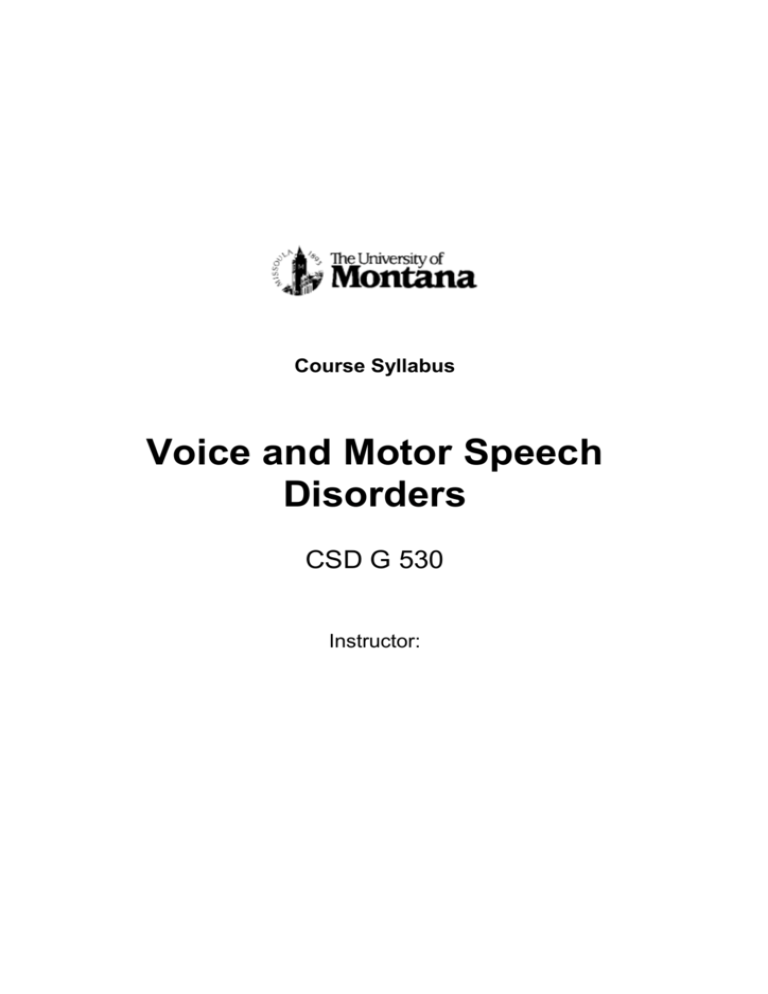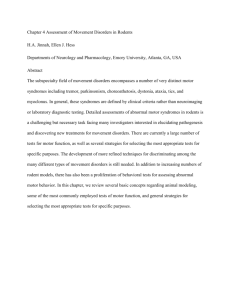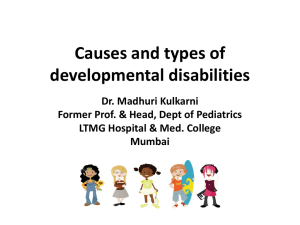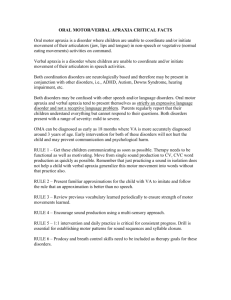Unit Information Shell Document - CDU
advertisement

Course Syllabus Voice and Motor Speech Disorders CSD G 530 Instructor: Contents Introduction UM Mission Statements Welcome About the Instructor Class Organization Learning Outcomes / Knowledge and Skills Acquisition (KASA) Class Times Class Attendance Policy Study Commitments Occupational Health and Safety Content overview Learning approaches Classroom Lectures Moodle Study Resources Required Texts Support Services and Resources Students with Disabilities Directory of Assistance Course Outline Resubmission Plagiarism Policy Student Code of Conduct Grading Scale 1 Introduction UM Mission Statements MISSION STATEMENT THE UNIVERSITY OF MONTANA The University of Montana capitalizes on its unique strengths to create knowledge, provide an active learning environment for students, and offer programs and services responsive to the needs of Montanans. The University delivers education and training on its four campuses and through telecommunications to sites inside and outside of Montana. With public expectations on the rise, the University asks its students, faculty, and staff to do and accomplish even more than they have in the past. The dedication to education for and throughout life reflects the commitment to service learning and community building on and off the campuses. The University enhances its programs through continuous quality review for improvement and remains fully accountable to the citizenry through annual audits and performance evaluations. MISSION STATEMENT THE UNIVERSITY OF MONTANA-MISSOULA The University of Montana-Missoula pursues academic excellence as demonstrated by the quality of curriculum and instruction, student performance, and faculty professional accomplishments. The University accomplishes this mission, in part, by providing unique educational experiences through the integration of the liberal arts, graduate study, and professional training with international and interdisciplinary emphases. The University also educates competent and humane professionals and informed, ethical, and engaged citizens of local and global communities; and provides basic and applied research, technology transfer, cultural outreach, and service benefiting the local community, region, state, nation and the world. Welcome Welcome to CSD 640. My hope is that you will find this course informative, interesting, comprehensive, and interactive. I strongly encourage class participation, questions, and discussion. Please do not hesitate to contact me at any time if you have questions or concerns about your obligations in this course. If you are struggling, please don’t delay in contacting me. If you have an honest desire to learn the material and are willing to put in the necessary work, I will do all that I can to ensure that you do well. I ask that your primary goal be to learn the material rather than just to achieve the best grade. About the Instructor Contact details are listed below: Phone: 406-243- Email: Mobile: Office Location: SHS CSD 640 Motor Speech and Voice Disorders 2 Office Hours: Postal Address: 32 Campus Dr., Missoula, MT 59812-6695 Course Organization This class is a lecture and seminar on motor speech and voice disorders. Topics include normal motor speech and voice function, as well as neurological bases, physical bases, clinical manifestations, and diagnosis and treatment of motor speech and voice disorders. The course provides the foundation to clinical practice for this group of patients. The first 8 weeks will cover motor speech disorders and the last 8 weeks will cover voice. There will be 2 exams (one on motor speech, one on voice) and 2 quizzes (1 for motor speech, 1 for voice), as well as two clinical projects*. The quizzes will count for approximately 10% of your grade. The projects will count for approximately 25% of your grade and the exams the other 65% of your grade. Keep in mind that because we are covering voice and motor speech in the same course, we will be moving through the material rapidly. Completing the chapter readings prior to class is highly recommended. If you need any extra help, please do not hesitate to contact me. Exams: The exams will be closed-book. That means if you are an off-campus student, you must find a proctor for the exams. Proctors need to be approved by me no later than two weeks prior to the exam. Specific guidelines for finding a proctor will be provided. Quizzes: Quizzes will be open-book but will have a time limit. Off-campus students will take the quizzes via Moodle at the same time that on-campus students take the quizzes in class. There is a total of 280 pts possible in this course. Following is the point breakdown for class assignments: Exams = 100 pts each (200 pts total), ~70% of total grade Quizzes = 20 pts each (40 pts total), ~15% of total grade Clinical Projects = 20 pts each (40 pts total), ~15% of total grade Conceptual Framework: This course provides a learning community that a) integrates ideas, b) encourages cooperative endeavors, and c) respects diversity and individual worth. These concepts are illustrated through the following activities: a) learning goal writing and treatment planning that provides applications across a variety communication disorders, b) participating in face-to-face discussions and online forums where students will interact with each other and the instructor to apply course concepts, c) writing assignments using a culturally unbiased manner and participating in course content related to services with individuals from diverse backgrounds. Learning Outcomes / Knowledge and Skills Acquisition (KASA) The ASHA Knowledge and Skills Acquisition (KASA) document details the Standards for the Certificate of Clinical Competence (SCCC). It is utilized to CSD 640 Motor Speech and Voice Disorders 3 demonstrate compliance with accreditation standards related to preparing students to meet ASHA certification requirements. It covers nine main knowledge areas (articulation, fluency, voice and resonance, receptive/expressive language, hearing, swallowing, cognitive aspects, social aspects, and communication modalities) across five clinical parameters (etiology, characteristics, prevention, assessment, and intervention). Due to the importance of the KASA standards in tracking and documenting the student’s achievement related to these knowledge areas and clinical parameters, they are directly related to the Learning Outcomes. Accordingly, the relevant Standard(s) are noted under each Learning Outcome. In this course, students’ knowledge of prevention, assessment, and intervention of motor speech and voice communication disorders will be assessed on exams and assignments. A competency must be Evident (70% or better) on these assessments to pass the ASHA standards. If a student does not meet the required standard, an individualized remediation plan will be developed. In some instances, a student may pass the course without passing all of the competencies. The table below outlines the competencies covered in this class and the criteria for meeting the competencies. CSD 640 Motor Speech and Voice Disorders 4 Knowledge Competencies III C Knowledge of motor speech and voice disorders Competency The student will: 1. Understand the nature of motor speech and voice disorders including their etiologies, characteristics, anatomical/physiological, psychological, and linguistic and cultural correlates. - - III D Knowledge of prevention, assessment, and intervention of motor speech and voice disorders 2. demonstrate knowledge of: - a) prevention, b) assessment, & c) treatment strategies in motor speech and voice disorders - Evaluation Method The student will: Correctly answer specific questions on examinations that address the nature of motor speech and voice disorders including their etiologies, characteristics, anatomical/physiologic al, psychological, and linguistic and cultural correlates. Complete a clinical project and/or research paper Correctly answer specific questions on examinations that address prevention, assessment, & treatment strategies in motor speech and voice disorders. Complete a clinical project and/or research paper Criteria Mastery: score of 90% or better Evident: score of 70-89% Not Evident: score below 70% Remediation Strategies The professor will provide supplemental readings and/or additional tutorials to support the student in a written assignment to meet this objective’s criteria. The professor will provide supplemental material for research and interpretation of literature to support the student in meeting this objective’s criteria on additional demonstrations of prevention, assessment, and treatment techniques. Class times: Class Attendance Policy Students are expected to perform better if they attend all class meetings and complete all assignments for courses in which they are enrolled. In the event of an absence each student is responsible to obtain any information presented or material distributed in class. The exam and quiz dates will be given well in advance, so you are expected to make sure that will be able to attend on those days. Exceptions for absences on exams and quizzes will only be made for extreme extenuating circumstances and require advance notice. CSD 640 Motor Speech and Voice Disorders 5 Study Commitments This is a 3-credit class. Conventional wisdom dictates that during a regular semester, one should spend 3-4 hours of time outside class for every credit. That works out to about a 12- to 15-hour weekly commitment (3 hours in class, 9-12 hours outside class). Obviously, there is some variation between students. Some will need to spend more time, while others will be able to complete their work in less. The time you put into this course should be spent completing the required reading, reflecting on your reading, discussing readings among your peers, and completing your assignments. This level of involvement will prepare you for each of the exams. Occupational Health and Safety There are no out of the ordinary risks associated with this unit. Content overview Topic 1: Substrates of motor speech disorders including defining, understanding, and categorizing motor speech disorders, the neurological bases, and examination. Topic 2: Types of motor speech disorders and their diagnoses including the dysarthrias, apraxia of speech, and psychogenic and nonorganic speech disorders. Topic 3: Differential diagnosis of motor speech disorders. Topic 4: Management of motor speech disorders. Topic 5: Normal anatomy and physiology of voice and resonance. Topic 6: Functional and organic voice disorders. Topic 7: Neurogenic voice disorders. Topic 8: Evaluation of voice disorders. Topic 9: Therapeutic management of voice disorders. Learning approaches Classroom Lectures and demonstration, reading assignments, video/audio presentations, class discussion, clinical observations. Moodle Moodle is the University of Montana’s on-line learning system. It is critically important that you maintain an accurate e-mail address with the University of Montana. In this unit, Moodle will be used to: CSD 640 Motor Speech and Voice Disorders 6 Provide important announcements regarding the course Provide a place to post questions about the course Provide lecture notes Provide assessment documents Provide supplemental resources Provide a digital dropbox for completed assignments You will need to connect to the Internet to access it, at: http://umonline.umt.edu/ Study resources Required texts: Duffy, JR 2005. Motor Speech Disorders (2nd Ed.). St. Louis, MR: Elsevier Mosby. Stemple, J. C., Glaze, L. E., & Gerdeman Klaben, B. (2010). Clinical voice pathology: Theory and management (4th Ed.). San Diego, CA: Plural Publishing. Support services and resources Students with Disabilities Students with disabilities are encouraged to plan ahead and can contact Disability Services for Students (DSS). For additional information, contact DSS Director Mary Lee Vance (marylee.vance@mso.umt.edu) or (406) 243-2243 (Voice/Text) or jim.marks@umontana.edu. Please visit http://www.umt.edu/dss/ to find details about the available services. DIRECTORY OF ASSISTANCE Concern Matters concerning the course Contact Laurie Slovarp Contact details Email: laurie.slovarp@umontana.edu Ph: 406-243-2107 General academic issues relating to your course Department Chair Refer to the UM website at http://www.umt.edu. & click the link to academics. Moodle difficulties IT Helpdesk Ph: (406) 243-help Website: http://umonline.umt.edu/ Difficulties accessing your Student Computer account IT Helpdesk Ph: (406) 243-help CSD 640 Motor Speech and Voice Disorders 7 Technical difficulties in PC Labs Library enquiries Website: http://umonline.umt.edu/ UM Library Ph: (406) 243-6866 UM Bookstore Ph: (406) 243-1234 Fax: (406) 243-2001 email: contact@umtbookstore.com website: http://www.umtbookstore.com Help with library databases, Internet searching and Reference queries Purchasing of text books and stationery University of Montana Bookstore University Center, 1st & 2nd Floor 5 Campus Drive, Missoula, MT 59801 General administration enquiries e.g. admissions/ enrolments, course information, graduation Ph: 406-243-2107 Course Outline Quizzes and Exams: There will be two quizzes and two exams. Quizzes will be open book and will be worth 20 points each; exams will be closed-book and worth 100 points each. Quiz 1 will cover motor speech disorders covered up to that point. Quiz 2 will cover voice disorders CSD 640 Motor Speech and Voice Disorders 8 covered up to that point. Exam 1 will cover all information on the motor speech section of the class. Exam 2 will serve as the final exam and will cover all information on the voice section of the class. Students who already took CSD 530 will only take quiz 1 and exam 1. Instead of quiz 2 and exam 2, they will complete a voice research paper and handout (see below). Projects: Clinical project: You will be given details of four patients - two with motor speech disorders and two with voice disorders. Based on the information you are given, you will provide the following: 1) most likely diagnosis, 2) prepare a treatment plan with a detailed description of what treatment strategies would be most appropriate given the diagnosis you pick, and 3) write short and long-term goals. You are expected to complete this project individually. Each case is worth 10 points. (Students who already took CSD 530 will only complete the voice cases.) Students who took CSD 530 last semester: If you already took CSD 530, which covered voice disorders, rather than taking the voice quiz, exam, and clinical project, you will write a paper and prepare a handout for your classmates on a special topic in voice disorders. This will allow you to broaden your understanding of voice disorders without significantly duplicating what you have already learned. The paper will be worth 100 pts. The handout will be worth 20 pts. Even though you will not be required to take the voice quiz or exam, it will be to your benefit, as well as your classmates, if you attend the voice lectures. With that in mind, the remaining 20 points allowable in the class will be earned by attending the voice lectures. You will be allowed to miss one of the voice lectures without losing points. You will lose 3 points per absence for two or more absences. If you must miss class due to extenuating circumstances, please let me know. Research paper: Students who took CSD 530 last semester will be assigned a special topic in the area of voice. You will write a 6-8 page, double spaced, paper in APA format. You will be required to do a thorough literature review on your topic, utilizing at least 3 empirical references. It is ok to use text books for additional information but text books will not fulfil the requirement for 3 empirical references. Keep in mind that 3 empirical references is just the minimum. Many topics will have many more than 3 references. The idea is for you to find what is most current and clinically relevant. If you fail to sight a reference that would significantly contribute to your topic, you may lose points. If you are having significant difficulty finding 3 empirical references, please come see me. If your topic is a treatment technique, your paper should include detailed information about how the treatment is done, for what population of patients the treatment is recommended for, and a review of the research. You should end your paper with a summary highlighting the treatment and conclusions about the level of efficacy. If your topic is a voice diagnosis, your paper should include an overview of the diagnosis and review of the research on management strategies for that voice disorder, with a conclusion about best practice (if possible, given what you find in the literature). Be sure to end your paper with a good summary. Handout: You will be required to create a short handout (1 to 2 pages) on your paper topic that summarizes your topic and treatment aspects of your topic. The handout needs to be turned in by Dec. 2nd so that I can review it and give feedback prior to handing it out to your classmates. The point of the handout is for your classmates to benefit from your research. It needs to summarize the topic and the most current treatment applications. It should be thorough enough to be a useful tool without requiring further CSD 640 Motor Speech and Voice Disorders 9 research but should also contain your reference list in case the reader wishes to gather more detailed information. Resubmission In this course, you cannot resubmit your work for reassessment. There will be no re-taking of quizzes or exams. Taking quizzes or exams on a different day than is scheduled will only be allowed in seriously extenuating circumstances that are completely unavoidable. You must give advanced notice for missing a quiz or exam and exceptions will be made on a case-by-case basis. Proctored exams must be taken on the same day as the on-campus students. Plagiarism Policy Plagiarism is the presentation of the work of another without acknowledgement. As defined by the University of Montana’s Student Conduct Code, plagiarism is “Representing another person's words, ideas, data, or materials as one's own.” Staff and students may use information and ideas expressed by others, but this use must be identified by appropriate referencing. Students who plagiarize may fail the course and may be remanded to Academic Court for a possible suspension or expulsion from the University. More information regarding student policy, academic misconduct, and plagiarism can be found at: http://www.umt.edu/catalog/policy_procedure.htm Student Code of Conduct The Student Conduct Code, embodying the ideals of academic honesty, integrity, human rights, and responsible citizenship, governs all student conduct at The University of Montana-Missoula. You are expected to follow this code. It is also expected that each student will help foster a collegial learning environment by sharing his or her experiential and academic knowledge and practices, as well as respectfully listening to the viewpoints of others and following basic netiquette rules. You are expected to complete all reading assignments, written work, group assignments, and examinations. Grading Scale There is a total of 280 points for this course. Final grades will be assigned as follows: Letter Grade Percentage A AB+ B B- 93-100 90-92 87-89 83-86 80-82 CSD 640 Motor Speech and Voice Disorders 10 C+ C CD+ D DF 77-79 73-76 70-72 67-69 63-66 60-62 59 or lower CSD 640 Motor Speech and Voice Disorders







